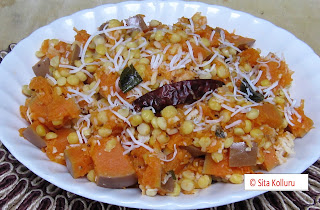Cranberries are acidic to taste and taste very much like vakkay in Telugu or karonda in Hindi.
Fresh cranberries can be frozen at home and will keep up to 9 months.
In some metropolitan cities in India, cranberries are available.
Cranberries can be called wonder fruit as they have many nutritional benefits. They help in preventing urinary tract infections. They are well known for anti-inflammatory benefits, cardiovascular benefits, anti-cancer benefits and antioxidant protection etc.
Cranberry sauce or relish are commonly associated with traditional Thanksgiving dinner.
Cranberries are usually processed into products such as juice, jam, sauce etc or sweetened dried. We can make some popular Indian dishes like chutneys or pickles etc I have tried sweet and sour chutney. If you prefer, you may fry some garlic pods in oil and use them as topping. It reminds one of popular Andhra tamarind sweet and sour chutney!
Now, fresh cranberries are available in stores.

Ingredients:
- 1 cup cranberries
- 1 Tsp. methi mustard powder
- 2 Tsp. chile powder
- 3 to 4 Tsp. jaggery
- Salt to taste
- 3 to 4 Tsp. oil
- A few garlic pods (peeled)
Directions:
- Wash and dry cranberries on a cloth.
- Heat a thick pan and add oil.
- When the oil is hot, add cranberries.
- Keep stirring till the cranberries pop.
- When all the berries popped up, remove from heat.
- Add chile powder, methi mustard powder, jaggery, and salt.
- Mix well and let the mixture stay in hot pan.
- If preferred, you can process the chutney in a grinder or just mash it with ladle
- If using garlic, fry the garlic in hot oil and add it to the chutney.
- Transfer the chutney to a bottle.
- The sweet and sour taste and the flavor are unique.









